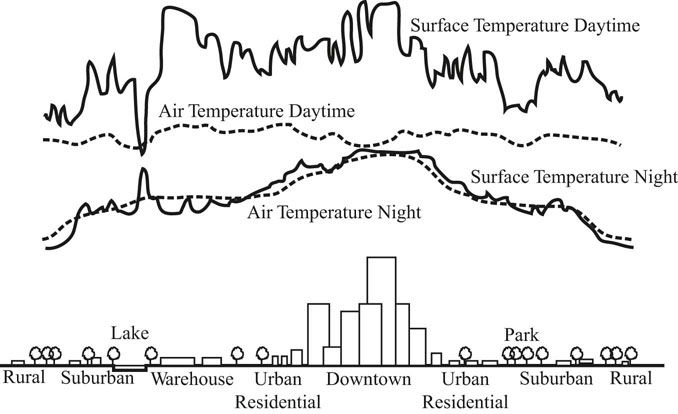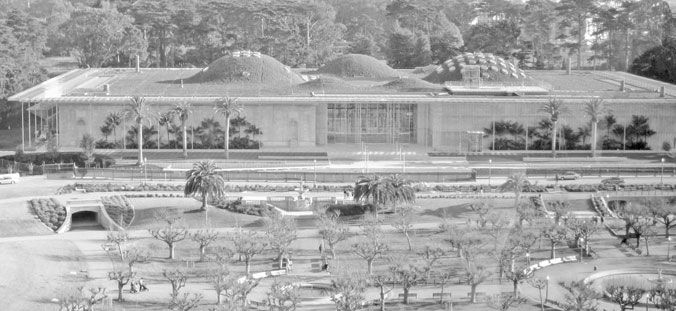Green roofs provide many benefits. They reduce cooling loads, by reducing the temperature of the roof surface by shading it and by evapotranspiration. The surface of a green roof, and thus the air directly above the green roof, will be significantly cooler than the surface of a traditional roof and the air above the traditional roof. This reduces the heat island effect seen in urban areas (Figure 25.1). A green roof protects the roof membrane from damage caused by sun and storms, and a green roof can create a park-like environment for people to use directly or use by looking onto the greenery.
Evapotranspiration is the process where plants draw water up through their roots, transpiration, and then evaporate the water as vapor from their leaves. The water is used along with carbon dioxide to create the molecules that the plant uses to construct itself. The waste product in this process is oxygen. The water evaporating into the air above the plants reduces the air temperature. On a Chicago roof with temperatures in the 90s, a green roof’s surface temperature ranged from 91 to 169 degrees Fahrenheit. A dark conventional roof on a nearby building was 169 degrees Fahrenheit. Also, the air temperature slightly above the green roof was 7 degrees Fahrenheit cooler than the air above the conventional roof (Hogan et al. 2008, 3).
Green roofs are classified into two categories. Extensive green roofs are not very deep and have hardy plants that can thrive on a roof top and can survive through low water times. Once established these roofs do not need much maintenance, and since the growing medium is only two to four inches thick, the structural weight of an extensive roof is not great. Extensive roofs can be located on sloped roofs up to about a 30 degree slope. Intensive green roofs have a growing medium that is somewhat deeper to a lot deeper than an extensive green roof. The depth of growing medium allows an intensive green roof to be more like a garden on the ground. The depth of growing medium also creates a considerable structural load, and there is more maintenance involved taking care of the plantings. Irrigation may be necessary.

FIGURE 25.1 The heat island effect over an urban area.
Source: United States Environmental Protection Agency, Heat Islands. www.epa.gov/heatisland.
Green roofs reduce energy use in buildings. In the summer, when the air is hot and the Sun is beating down, a green roof reduces the part of the cooling load that comes through the roof. This is enhanced when the growing medium is wet. The thermal mass of the green roof provides a slight reduction in the heating load through the roof, but the reduction in cooling load through the roof is more prominent, approaching a 75 percent reduction. Green roofs take in carbon dioxide and give off oxygen, and can make modest reductions in air pollutants like particulate matter, NOx, SOx, CO, and ground level ozone. A 1,000 square foot green roof can absorb the particulate matter produced by 15 cars over a year’s time. Green roofs aid in storm water management. Green roofs absorb rain water and hold on to it for a while. More water is contained in a deeper intensive green roof than in a thin extensive green roof. Evapotranspiration puts some of the water back into the atmosphere. Depending on the green roof type 50 to 100 percent of the water falling on the roof is retained on the roof. Even if a green roof cannot contain all the water that falls on it, the roof delays the runoff, which reduces peak runoff while also filtering the runoff. Finally green roofs provide improved quality of life. Intensive green roofs can provide outside green spaces for people in tall buildings. Both intensive and extensive green roofs often are coordinated with outside decks so occupants can enjoy the green outdoor space even if walking on the roof is not advisable. Green roofs can also provide habitat for species in threat (Hogan et al. 2008, 5–10).
The California Academy of Sciences building in Golden Gate Park in San Francisco, designed by Renzo Piano, is a LEED Platinum building. It has a 2.5 acre green roof designed by Ran Creek. The green roof is a mix of native annual and perennial plants designed to provide habitat for butterflies (Wels 2008, 66–75). The building produces 50 percent less waste water than the old building. Rainwater is used for irrigation. There are 60,000 photovoltaic cells mounted on an overhang that surrounds the building and 90 percent of the occupied areas are naturally illuminated. Recycled steel and concrete were used in the construction and the insulation was made from scraps of denim (Wels 2008, 58–63).

FIGURE 25.2 The green roof on the California Academy of Sciences Building in Golden Gate Park, San Francisco, California. The architect was Renzo Piano, and the green roof was designed and installed by Ran Creek in 2008. Photo by Carl Bovill.
A green roof costs more than a conventional roof but the owner of the building needs to consider the energy savings associated with the green roof, and the municipality should provide a storm water management benefit to the building because of the green roof. Then there are the habitat benefits and the heat island benefits that are difficult to put a value on.
The structure of a green roof starts with the growing medium, which is mostly inorganic material with only 20 percent soil. Extensive roofs have 6 inches or less, and intensive roofs have 8 inches or more. Below the soil is a membrane designed to let water through but hold back the growing medium. The next layer is a drainage matt so excess water can drain away. Below that is a root barrier to keep invasive plant roots from penetrating the roof membrane. Closed cell thermal insulation is the next layer. And finally the roof membrane is applied on top of the structural deck. Ideally the roof membrane is adhered to the roof deck so that any future roof leak problems can be located easily. If the roof membrane is not adhered to the roof deck or is located above the roof insulation water from a leak can travel underneath the membrane before finding a path into the building below. Finding the cause of the leak is then much harder. Extensive green roofs require plants that have shallow roots, that are self-propagating, and that can withstand the extreme temperature, sun, and wind conditions on a high roof. Succulents meet all these criteria and are drought resistant. Intensive green roofs with their deeper growing medium can have a wide variety of plants from grasses, through shrubs, to trees (Hogan et al. 2008, 15–16). Roofmeadow is a green roof company located in Philadelphia, PA. Their website (www.roofmeadow.com) has a wealth of information on detailing green roofs.

FIGURE 25.3 A cross section through a typical green roof.
Some maintenance is necessary. During the first year or two, as the roof is establishing itself, weeding will be required. After that a slow release fertilizer is often necessary. Extensive green roofs may need irrigation as they mature but should be designed to live off the natural rain supply. Intensive green roofs can require irrigation depending on the climate. As with planted gardens on the ground replanting will be needed at times. Dry plant materials on a roof can pose a fire safety problem. An irrigation system can mitigate this and fire breaks approximately 2 feet wide will contain the spread of a fire if one gets started (Hogan et al. 2008, 16–18).
The U.S. Green Building Council LEED green rating system provides points for the benefits that green roofs provide.